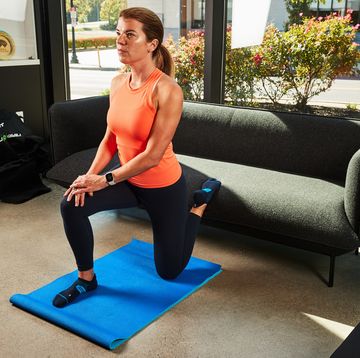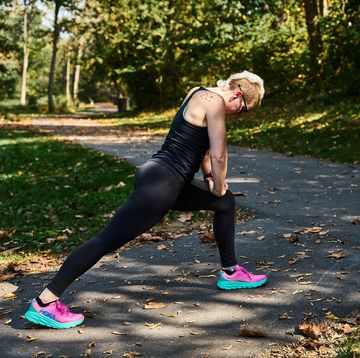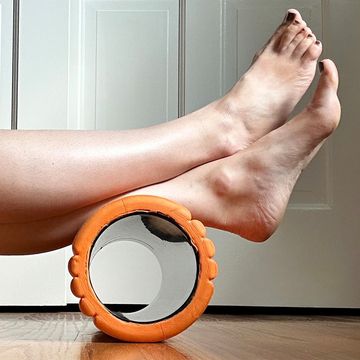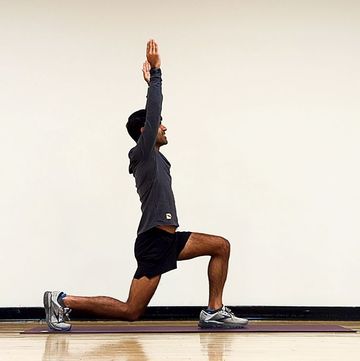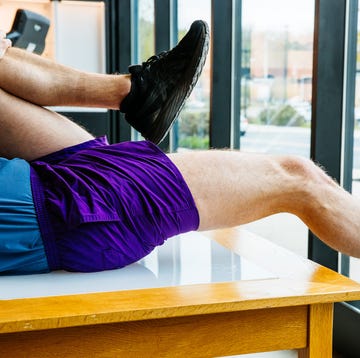Watch a group of elite runners warming up and you won't see any of them bending over trying to reach their toes. Instead, you'll see athletes moving their bodies to improve their range of motion, increase flexibility, and guard against injury. "Stretching has progressed to a more functional, dynamic method," says physical therapist Chris Frederick, codirector of the Stretch to Win Institute in Tempe, Arizona. "It helps runners of all levels perform better."
You may be familiar with dynamic warmup moves like butt kicks and high-knee marches. But physical therapists and trainers have developed other ways to stretch your body in a more functional way. Consider the upsides and downsides of these three new methods to decide which works best for you.
FASCIAL STRETCH THERAPY
Unlike stretching that attempts to isolate and stretch specific muscles, fascial stretch therapy (FST) targets fascia, the connective tissue found in, around, and between joints. To stretch the fascia, a certified FST therapist gently pulls then moves the legs, arms, spine, and neck in a smooth motion at various angles to remove pressure between joints, release joint-lubricating synovial fluid, and improve flexibility of muscles. "The function of muscles cannot be separated from the movement of fascia," says Frederick, who has worked with Olympic gold-medal sprinter Sanya Richards. After an initial session with a therapist, runners can continue this stretch therapy on their own.
UPSIDES: "Runners tell us that after the first FST session they move with more ease and feel stronger and faster," Frederick says. Runners using FST also report increased stride length, less pain and tightness, and faster recovery.
DOWNSIDES: You can't do the initial session on your own. The at-home stretches can take some time to master.
HOW TO: Visit stretchtowin.com to find an FST therapist. A session with a certified FST therapist costs $60 to $200 per hour. Frederick's book, Stretch to Win, and DVD, Flexibility for Sports Performance, also offer FST instruction.
KI-HARA RESISTANCE STRETCHING
Most forms of flexibility training start with relaxing the muscle you're about to stretch. But with Ki-Hara, you use resistance (by yourself, or with the help of a trainer) to keep the muscle that you're stretching contracted throughout each movement (see "Leg Warmers," below). Keeping muscles engaged stabilizes them, which can help prevent injury, says trainer Anne Tierney, cofounder of Ki-Hara. "This method stretches a muscle the way it's used." The technique also focuses on training opposing muscle groups together, like hamstring and quads, to address imbalances. During assisted sessions, Ki-Hara trainers use a technique called mashing, where they use their feet to help loosen muscles and release fascia to flush toxins and improve circulation. American steeplechase record holder Jenny Barringer Simpson is a Ki-Hara devotee.
UPSIDES: Ki-Hara's unique approach builds flexibility and strength at the same time and helps remove lactic acid. "An assisted Ki-Hara session that incorporates resistance stretching and mashing can really aid recovery," Tierney says. Athletes use Ki-Hara before a run to loosen up, or after to reduce stiffness and tension.
DOWNSIDES: The movements can be difficult to learn to do effectively without one-on-one help from a Ki-Hara trainer.
HOW TO: To buy an instructional DVD or to find a trainer in your area, go to innovativebodysolutions.com. Sessions cost between $75 and $350.
FACILITATED ACTIVE STRETCH TECHNIQUE
This method of active stretching helps break up scar tissue in injured and chronically tight muscles. By applying pressure with your fingers around a tight or injured area or on a series of points running up and down the muscle while extending and contracting it, you can relieve the pain of current injuries, improve range of motion, and prevent future damage. "In a conventional stretch you're stretching an entire muscle," says sports chiropractor Rob DeStefano, creator of the F.A.S.T. technique. "With this method, you focus the movement at a specific area of tightness."
UPSIDES: You can use this massage and stretching technique to help warm up muscles before a run, or even during a run or race to work out tight spots. "With a little practice, you'll be able to target specific areas of tightness, making your stretch more effective," DeStefano says.
DOWNSIDES: The angle and amount of pressure to put on the muscle can take time to get right. DeStefano's instructional book lacks in-depth descriptions of techniques for helping knee or shoulder pain; if you have those problems, you may need to see an active-stretching therapist.
HOW TO: Go to muscleinjuries.com for details about the technique and DeStefano's instructional book, Muscle Medicine, or to find an active-stretching therapist skilled in the F.A.S.T. technique. Sessions start at $50/hour.
FEEL BETTER: A dynamic warmup for runners includes walking lunges, leg lifts, and butt kicks. For a video demo, go to runnersworld.com/dynamicstretching.
Leg Warmers
Enhance mobility with three Ki-Hara stretches before you run
HAMSTRINGS
Lie on your back with your knees bent. Bring your left knee toward your right shoulder and grab your heel (or calf). Press your left heel down toward your glutes as you contract your hamstring. Then lengthen your leg toward your right shoulder. Repeat three times per leg.
QUADRICEPS
Lie on your back with your knees bent. Drop your right knee inward and place your left ankle just above your right knee. Using your left leg for resistance, slowly raise your right knee. Next, push the right knee toward the mat while resisting with your left leg. Repeat three times per leg.
OUTER THIGH
Lie on your back and cross your left foot over your right knee. Clasp your hands around the right leg. Push out with the left leg, contracting your glutes and the outside of your thigh, while using the right leg and your arms to pull the leg toward your chest. Repeat three times per leg.
Beth (she/her) is the executive editor of Good Housekeeping, where she oversees all print content and manages features, personal essays and special projects for the brand. She is a former executive editor at Woman’s Day and features director at Reader’s Digest and a current adjunct professor at New York University in the School of Professional Studies. As a former college and semi-professional soccer player, she twice had the unfortunate experience of playing against Abby Wambach.






